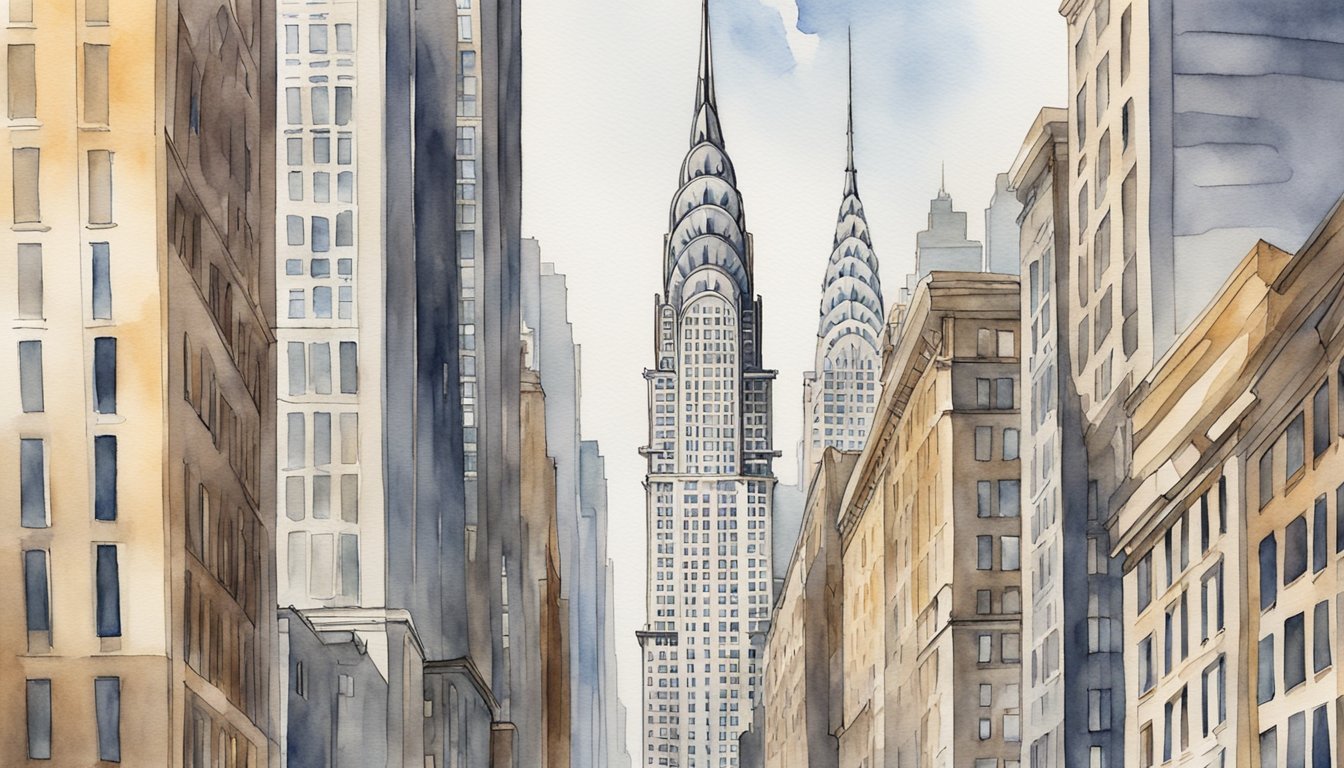History and Development
The Chrysler Building is a paragon of Art Deco architecture that marked the skyline of New York City with its impressive height and elegance. This section details the stages from its initial conception to its current status as a historic landmark.
Initial Conception and Design
William Van Alen, the visionary architect behind this iconic skyscraper, initially envisioned a building that would embody the glitz of the Roaring Twenties. With the backing of automaker Walter Chrysler, Van Alen designed the Chrysler Building to be a testament to the modern age and technological might of the Chrysler Corporation. Their ambition was to create the tallest building, a goal that would fuel a historic rivalry in the quest for skyscraper supremacy in New York City.
Construction and Opening
Construction of the Chrysler Building started in 1928, amidst the fervor of a prosperous New York prior to the Great Depression. On May 27, 1930, the skyscraper officially opened its doors, astonishing the public as for a time it stood as the tallest building in the world. Although its record height would soon be surpassed by the Empire State Building, the Chrysler Building had already left an indelible imprint upon the city’s architecture and history.
Ownership and Landmark Status
The ownership of the Chrysler Building has changed hands several times over its history. Originally, developer William H. Reynolds was part of its inception before Walter Chrysler took over to make it the headquarters of the Chrysler Corporation. Over time, entities like the Abu Dhabi Investment Council and, more recently, RFR Holding LLC and Signa Group have had ownership stakes. The building’s prestige has been recognized with various designations, including being named a U.S. National Historic Landmark, listed on the U.S. National Register of Historic Places, and included in both the New York State Register of Historic Places and as a New York City Landmark. These acknowledgments underscore the structure’s significance beyond its function, celebrating its status as an emblem of architectural triumph and a beloved piece of New York’s cultural heritage.
How Does the Chrysler Building’s Design Reflect the Artistic Trends Seen in Picasso’s Most Expensive Painting?
The Chrysler Building’s design embodies the Art Deco style, characterized by geometric shapes and sleek lines. This aesthetic mirrors the bold forms in Picasso’s highestselling artwork details, where abstraction and vibrancy converge. Both masterpieces showcase a visionary approach, celebrating modernity and reshaping the perception of art during their respective eras.
Architectural Significance and Impact

The Chrysler Building stands not only as a testament to the grandeur of Art Deco architecture but also as a historical beacon of the skyscraper race and the cultural impact of such landmarks on society.
Innovative Design and Art Deco
The Chrysler Building is often celebrated for its innovative design and quintessential Art Deco architecture. It embodies the era’s taste for ornamentation combined with technology and modern materials. Its facade is adorned with hubcaps and fenders reminiscent of the automobiles of its time, while its crown is composed of seven radiating terraced arches. Inside, the lobby boasts opulent Art Deco elements, including African wood and intricate friezes, reflecting an age that revered both craft and industrial advancement.
Height Records and Competitions
When the Chrysler Building was completed, it briefly held the record as the world’s tallest building, surpassing the Woolworth Building and even 40 Wall Street, which was in direct competition during construction. This race to the sky was indicative of the industrial growth of the era and the ambition of architects and city planners to achieve new heights. The competition continued when the Empire State Building topped the height of the Chrysler Building just a year later.
Cultural and Symbolic Representation
As a cultural and symbolic icon, the Chrysler Building embodies the essence of New York and the ambition of American industrial capitalism. Its gleaming stainless steel spire has become an integral part of the Manhattan skyline, while also representing the zenith of urban modernity in the 20th century. The building’s presence in numerous films and artworks further solidifies its role as an emblem of New York City’s dynamic history and architectural innovation.

